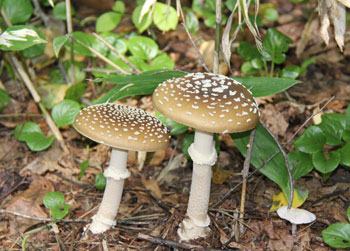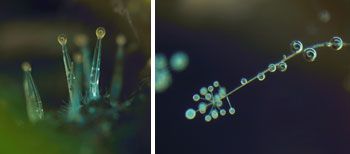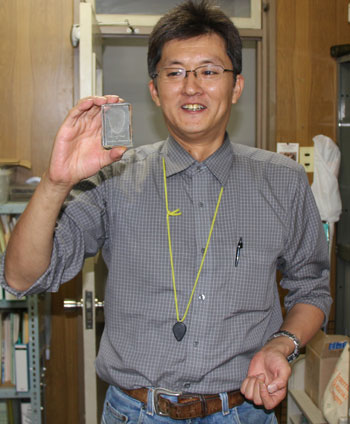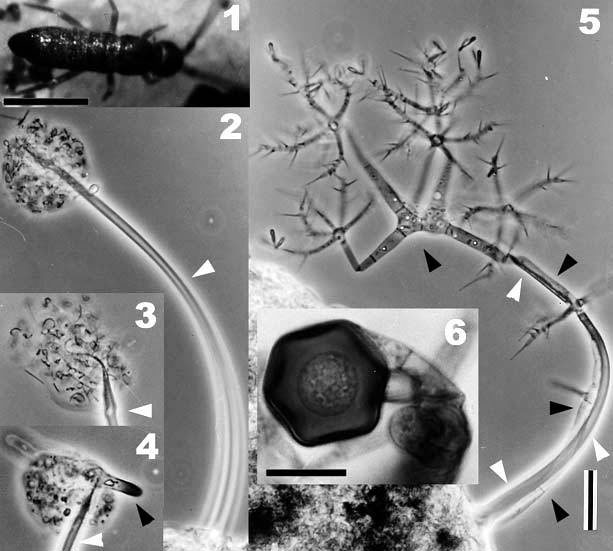TSUKUBA FUTURE
#012 Striving to Understand the Dazzling Diversity of Life
Assistant Professor DEGAWA Yosuke, Faculty of Life and Environmental Sciences


As a child with a weak constitution that often caused him to skip school, Professor Degawa enjoyed looking at illustrated books of mushrooms. He would look for mushrooms and other small organisms in his yard and nearby parks. Of course, he was never able to find the brilliant, colorful mushrooms that caught his eye in his picture books. Still, he was able to find and observe pill bugs and slime molds (myxomycetes), with their strange shapes, colors, and ecologies. As a junior high school student, he began conducting research on myxomycetes and participating in the Japanese Society of Myxomycetology. Later, he followed a straight course toward becoming a mycologist. When getting ready for college, without hesitation he selected the University of Tsukuba, with its strong reputation in the field of mycology.
From the time he began researching his senior thesis topic, and into his time as a graduate student, he dedicated himself to conducting research at the University of Tsukuba Sugadaira Montane Research Center, located in the suburbs of Ueda City in Nagano Prefecture. Sugadaira is a highland with treasure trove of fungi. There are mushrooms, of course, as well as a variety of other fungi just waiting to be discovered. The Center's many staunch naturalists including arthropodologists, botanists, and ecologists often gave him information about cases of fungi growing on insects. A new species of fungus (Myconymphaea yatsukahoi) that grows on primitive arthropods was also discovered at the Center. The research topic Prof. Degawa chose for his doctoral dissertation was thus the fungi that live on arthropods, specifically, Mortierella, a fungus that grows on the carcasses of the same pill bugs that enchanted him in his youth.

(Upper left photo) A type of Mortierella growing on the carcass of a sow bug
(Lower left photo) The necklace of the sporangium is one of its most wondrous features.

(Left): A Mortierella species living on a cicada's shell
(Right): A Mortierella species living on a millipede carcass
The discoveries he made during his time as curator at the Kanagawa Prefectural Museum of Natural History, located at the entrance to Hakone, also seemed to be part of Prof. Degawa's destiny. Upon studying the fungi that grew in some soil he took home with him from a forest in Hakone, he learned that it was an organism found only in the forests of Canada in 1993. While its details still have not been clarified, it has been named Aenigmatomyces, meaning "enigmatic myces." To explain this enigma, Prof. Degawa continued his observations. As a result, he learned something extraordinary. Fungi do not make nutrients on their own. They have to obtain nutrients by breaking down organic matter. Many fungi specialize in breaking down a specific organism. For example, Mortierella specializes in the carcasses of pill bugs and other bugs of the same group.
This Aenigmatomyces is a fungus that infests the spermatophores of slender springtails, another family of primitive arthropods. A spermatophore is the mass produced when a male springtail rolls up his sperm in jelly, places it on top of a stalk, and then leaves it on a dead leaf. The female then finds it and takes it up into her body, thus inseminating herself. The Aenigmatomyces grows on the unused spermatophores. This explains one of its enigmas. The behaviors of the springtails are strange enough, but the life cycle of the Aenigmatomyces is far stranger. As a result of Prof. Degawa's research, the Aenigmatomyces was selected as the first recipient of the Japanese Rare Fungus Prize, which was established by the Young Mycologists Group of the Mycological Society of Japan in 2013.

The extra prize of the Japanese Rare Fungus Prize was a death mask miniature of the myxomycete research pioneer Kumagusu Minakata. Prof. Degawa always carries a magnifying glass with him, hanging from his neck, so he is ready to make careful observations of the world around him at any time.

The rare fungus, Aenigmatomyces
(1) A slender springtail (2)(3) Spermatophore of a slender springtail. The string-shaped sperm is floating in the jelly capsule on top. (4) Young fungus elongates from within the spermatophore. (5) Mature fungus. The part that looks like the stem of the fungus is actually the spermatophore stalk. The Aenigmatomyces fungus (black arrow) is wrapped all around the slender springtail spermatophore stalk (white arrow). (6) Mature zygospore. The short stem that extends to the right is connected to the fungus.
Since Prof. Degawa returned to the Sugadaira Montane Research Center in 2009, he has taken like a fish to water to the vigorous promotion of research on exotic mushrooms. His most recent achievement was the discovery of a strange relationship between fungi, and camelback crickets and house centipedes. He is learning about the unusual symbiotic relationships between fungi and animals, and the alternation of generations of fungi, whose life cycles have thus far been largely unexplained, occurs through the use of the bodies of these animals. It is estimated that there are about 1.5 million different species of fungi in the world, but only about 100,000 of those have been named. Only a mere 15,000 have been discovered in Japan. Fungi are playing an important role in the energy cycle in the global ecosystem. As part of its efforts to cover the diversity of the organisms that live around it, the Sugadaira Montane Research Center is conducting an inventory of the Sugadaira fungi. Generally, molds are considered unpleasant, but Prof. Degawa passionately explains that understanding molds leads to understanding the earth.
Article by Science Communicator at the Office of Public Relations


